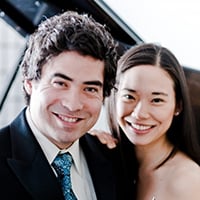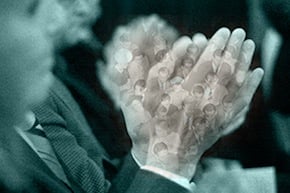
Sunday’s Marin Symphony concert was remarkable for its thoroughly audience-pleasing results. A warm glow and the evident enjoyment of Kenji Bunch’s Piano Concerto made up the first half, and an instant, universal, and cheer-accompanied standing ovation followed the second-half’s Symphony No. 1 of Gustav Mahler. Should we thank the composers or the performers for this?
Of course, it’s always both, but in this case, I ascribe most of the cause of the respective responses to the composers. In Bunch’s concerto, the highly enjoyable music was not focused enough on the pianist — Bunch’s wife, Monica Ohuchi — to get the audience on their feet; in the Mahler, Music Director Alasdair Neale proved that focusing on titanic climaxes was pretty much all that was necessary to pop up his patrons.
Bunch is an up-and-coming composer from Portland, Oregon, who has made a name for himself in New York merging classical and pop music elements into an attractive, relatively unchallenging mix that’s in tune with the current eclectic plateau of musical fashion. As he confessed in the program notes, Bunch originally wanted to “subvert the conventions” of the piano concerto, “one of the classic milestones in a composer’s trajectory — a yardstick that has inspired and intimidated me for years.” But in the end, he chose to “fully embrace the tradition,” in the standard, three-movement vehicle, which was premiered earlier this year in Colorado.
Concertos usually draw the greatest response from audiences when the soloist has ample opportunities to amaze viewers with his or her virtuosity, alternating blazing pyrotechnics with soulful melodies. This aspect of tradition was scarcely embraced by Bunch; instead, he used his fine ear for orchestration to carry the bulk of his musical argument among sections and soloists in the orchestra. Ohuchi dutifully and gracefully accompanied her cohorts in minimalistic patterns, some derived from études her husband had written earlier for her.
The third movement came alive with samba rhythms and a tinge of Mantovani-like strings.
While the music allotted to Ohuchi was less attractive than her floor-length, pleated, platinum-toned gown, the orchestral side of the composition was a distinct pleasure to listen to. Bunch employed a particular rhythmic tattoo as a glue to tie together his otherwise contrasting movements. The first movement, “Sparkling,” displayed a trickly, postminimalist edge and some chords reminding me of Holst’s ”Saturn” movement from The Planets. The second movement, in particular, was a gem, and the most traditional, featuring a gorgeous (if somewhat subdued) melody in the English horn that even reached the piano eventually. The third movement came alive with samba rhythms and a tinge of Mantovani-like strings.
Meet the Composer

Every attendee I spoke to during intermission told me they enjoyed Bunch’s music. During that break, the Symphony employed the innovation of having the composer and soloist stand in a stall near the box office, where they could be approached by anyone who had something to say. Far too few did. I hope the idea is continued so that people will become accustomed to it and take advantage of that comment opportunity. But I can’t imagine that most artists will agree with the concept. Performing can be exhausting, so collapse in the dressing room and a drink are more attractive than having to field occasionally naive or even embarrassing questions from a crowd.
After intermission came something of an ordeal: a Mahler First about 10 minutes longer than usual, and of undue challenge to the horn section, especially about 4 minutes into the last movement. Fortunately, Neale built memorable high points that made up for the intermediate stretches of occasionally dicey ensemble work. This, along with the inherent drama of the music, plus some fine playing by the principal trumpet and bass violin, was enough to bring home the day for the appreciative attendees.
Marin Symphony’s next subscription concert should receive equal acclaim. It will feature the Third Symphony from the tonal and melodically agreeable Lowell Liebermann; Elgar’s famous Cello Concerto; and, in an amusing misprint in the program, Dvořák’s “Symphony No. 41 in E Minor” — a new number for the New World.

